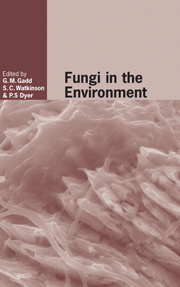Book contents
- Frontmatter
- Contents
- List of contributors
- Preface
- I Imaging and modelling of fungi in the environment
- 1 Imaging complex nutrient dynamics in mycelial networks
- 2 Natural history of the fungal hypha: how Woronin bodies support a multicellular lifestyle
- 3 Environmental sensing and the filamentous fungal lifestyle
- 4 Berkeley Award Lecture: Mathematical modelling of the form and function of fungal mycelia
- II Functional ecology of saprotrophic fungi
- III Mutualistic interactions in the environment
- IV Pathogenic interactions in the environment
- V Environmental population genetics of fungi
- VI Molecular ecology of fungi in the environment
- Index
- References
4 - Berkeley Award Lecture: Mathematical modelling of the form and function of fungal mycelia
from I - Imaging and modelling of fungi in the environment
Published online by Cambridge University Press: 03 November 2009
- Frontmatter
- Contents
- List of contributors
- Preface
- I Imaging and modelling of fungi in the environment
- 1 Imaging complex nutrient dynamics in mycelial networks
- 2 Natural history of the fungal hypha: how Woronin bodies support a multicellular lifestyle
- 3 Environmental sensing and the filamentous fungal lifestyle
- 4 Berkeley Award Lecture: Mathematical modelling of the form and function of fungal mycelia
- II Functional ecology of saprotrophic fungi
- III Mutualistic interactions in the environment
- IV Pathogenic interactions in the environment
- V Environmental population genetics of fungi
- VI Molecular ecology of fungi in the environment
- Index
- References
Summary
Introduction
In most environments, the spatial distribution of nutrient resources is not uniform. Such heterogeneity is particularly evident in mineral soils, where an additional level of spatial complexity prevails owing to the complex pore network in the solid phases of the soil. Mycelial fungi are well adapted to growth in such spatially complex environments, since the filamentous hyphae can grow with ease across surfaces and also bridge air gaps between such surfaces. This ability is significantly enhanced by the propensity of many species to translocate materials through hyphae between different regions of the mycelium. Thus, it has been suggested that hyphae growing through nutritionally impoverished zones of soil, or deleterious regions (e.g. localized deposits of organic pollutants, toxic metals, dry or waterlogged zones), can be supplemented by resources imported from distal regions of the mycelium (Morley et al., 1996). This has profound implications for the growth and functioning of mycelia and attendant effects upon the environment in which they live. Thus, the fungal mycelium represents an extremely efficient system for spatial exploration and exploitation.
The study of filamentous fungi through experimental means alone can be very difficult owing to the complexity of their natural growth habitat and the range of scales over which they grow and function. Mathematical modelling provides a complementary, powerful and efficient method of investigation and can provide new insight into the complex interaction between the developing mycelium and its environment.
- Type
- Chapter
- Information
- Fungi in the Environment , pp. 58 - 74Publisher: Cambridge University PressPrint publication year: 2007



